Essential Tips for Buying Kitesurfing Gear
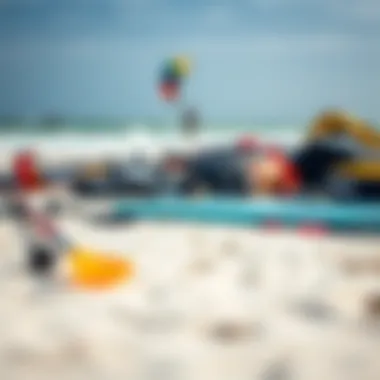
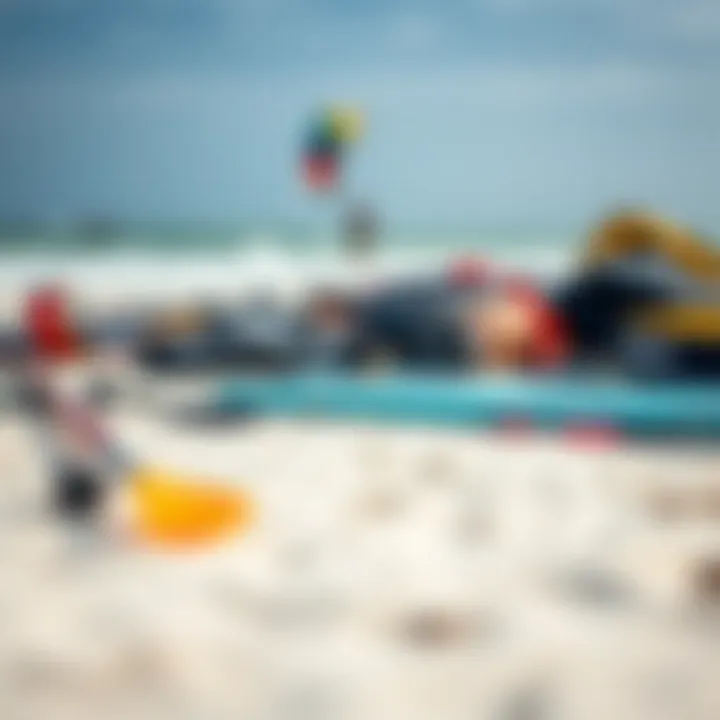
Intro
Kitesurfing brings a unique thrill that few other sports can match. Riding the wind and waves offers a blend of adrenaline and serenity. Yet, before you hit the water, understanding the gear and equipment that make this sport not just possible but pleasurable is essential. This guide provides insights into kitesurfing setups currently available for sale, educating both newcomers and seasoned riders alike.
Selecting the right gear is more than just a shopping spree. It involves knowledge of various aspects like equipment type, quality evaluation, and even purchasing tips. Proper preparation ensures that you enjoy every moment on the water and enhances the overall kitesurfing experience.
The guide will cover various elements, including:
- Essential equipment for those just beginning their journey.
- Advanced setups for experienced riders aiming to up their game.
- Safety practices that protect you amid the exhilaration of kiteboarding.
- Training techniques to muscle through skill improvement.
Arming yourself with this information will set you on course for making a wise investment in kitesurfing gear, while simultaneously amplifying your joy during rides.
Understanding Kitesurfing Equipment
When it comes to kitesurfing, gear is king. Understanding kitesurfing equipment is crucial not only for safety but also for maximizing your experience on the water. This chapter dives into the essential components of kitesurfing gear, helping you make informed decisions when selecting your setup. By breaking down the different elements, from kites to boards to harnesses, readers can grasp the significance of each component and how it impacts performance.
Key Components of Kitesurfing Gear
Kite Types and Sizes
Kite types and sizes are the centerpiece of your whole kitesurfing experience. Choosing the right kite can make a world of difference in how you handle the water. There are basically three types you’ll often come across: C-kites, Bow kites, and Delta kites.
- C-kites are known for their precise handling and strong power but are often less forgiving for beginners. Their classic design allows for great performance in jumping and tricks.
- Bow kites, on the other hand, offer more stability and are usually easier to relaunch; this aspect can be particularly handy if you find yourself in a pinch.
- Delta kites are characterized by their flat shape, providing excellent lift and wind range adaptability.
Each type has its own strengths and weaknesses; some are designed for specific conditions or riding styles. Size matters too! A larger kite can lift you higher, while a smaller one grants you better control in strong winds. Therefore, knowing about kite types and sizes can guide your choice effectively, keeping you safe and enhancing your kitesurfing adventures.
Boards: Shapes and Sizes
Boards are another key component that directly affects your kitesurfing. The variety in board shapes and sizes offers diverse options tailored to different styles, whether you're into jumping or cruising. Common categories are: Directional boards and Twin-tip boards.
- Directional boards are specifically designed for wave riding and are perfect for those who love the ocean. Their pointed shape helps cut through waves effectively.
- Twin-tip boards offer versatility and are the most common among new kiteboarders. This type allows you to ride in either direction, making them a popular choice for freestyle tricks and smooth rides.
Another aspect to consider is board material, which can affect durability and weight. A good setup balances weight and size relative to your skill level and intended use. Understanding these nuances in boards can greatly influence your kitesurf performance.
Harnesses and Control Bars
Harnesses and control bars might seem like small potatoes in the grand scheme of kitesurfing, but they genuinely hold everything together. Your harness connects you to the kite, distributing the pull effectively across your body. There are two main types: Waist harnesses and Seat harnesses.
- Waist harnesses are suitable for most styles, offering freedom of movement essential for tricks.
- Seat harnesses provide comfort and support, particularly beneficial for beginners or riders who plan to spend long hours on the water.
Control bars are your primary interface with the kite. Features like the bar length and the distance from the lines contribute significantly to comfort and handling. A well-designed control bar can make your riding smoother and more responsive.
Types of Kitesurfing Setups
Understanding the different setups in kitesurfing unveils the breadth of possibilities available to riders. Each setup has tailored purposes, which can cater to specific riding styles and conditions.
All-round Setups
An all-round setup provides versatility, catering to riders who do a bit of everything — freestyle, wave riding, and cruising. These setups typically include a medium-sized kite and twin-tip boards, helping you adapt to different conditions.
What makes this choice beneficial is its flexibility. If you’re still figuring out what you enjoy most, an all-round setup covers plenty of bases without breaking the bank.
Freestyle Setups
If your aim is to pull off stunts and tricks, a freestyle setup should be your go-to. This includes a smaller kite designed for quick turns and a board that emphasizes pop and control.
Freestyle setups are known for their ability to help riders execute jumps, spins, and other maneuvers. The lighter weight of these kits allows for better aerial performance but might require more skill to handle.
Wave Kiting Setups
Wave kits are specifically crafted for surf conditions. This setup usually combines larger kites with a directional board designed to ride waves smoothly. The unique feature here is their ability to slice through rough water, giving riders more control over their direction.
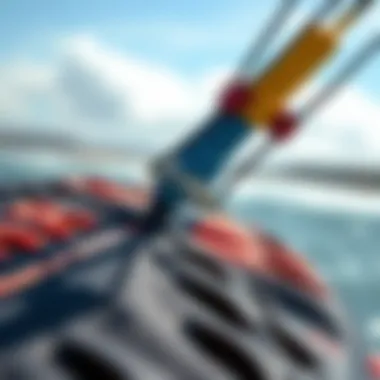
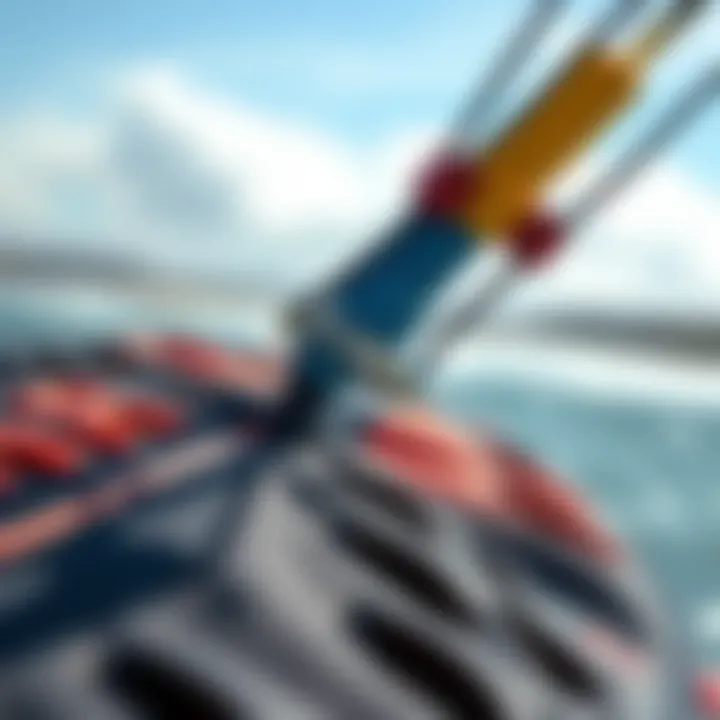
While they offer an adrenaline rush, mastering wave kiting requires time and experience, as the dynamics can be quite different from flatwater kiting.
By grasping these concepts in kitesurfing gear, you'll be better equipped to navigate choices in equipment that truly suit your riding style.
Understanding kitesurfing equipment from kites to harnesses is integral to finding the right setup and elevating your experience on the water. Each component contributes its own unique flair to the overall practice, ensuring that every session is both exciting and safe.
Evaluating Quality in Kitesurfing Setups
When you're ready to purchase kitesurfing gear, evaluating the quality of the setup is as critical as the decision to take up the sport. The right equipment can massively influence your performance, safety, and overall enjoyment on the water. Not all kitesurfing setups are created equal; therefore, knowing how to inspect their quality ensures you’ll make an investment that returns fantastic experiences rather than headaches.
New vs. Used Kitesurfing Gear
Pros and Cons of New Gear
Buying new gear comes with its share of benefits and drawbacks. One of the major advantages is the guaranteed reliability. Brand new kites, boards, and harnesses are often made using the latest technologies and materials, ensuring top performance and safety features. The thrill of having a shiny new kite that hasn't faced harsh conditions can certainly not be understated.
However, the price tag that comes with new equipment can turn some away. New setups tend to be on the higher side of the budget, which might discourage newcomers or those just testing the waters of this sport. Furthermore, there are some kitesurfers who argue that you don’t always need the latest gear to have a great experience.
Assessing Used Gear Condition
On the flip side, the used kitesurfing market can be a treasure trove for savvy buyers. But jumping into used gear without proper assessment can lead to pitfalls. The key characteristic that differentiates used gear from new is its history—how many sessions it has seen, the conditions it has faced, and its overall wear and tear.
To assess used gear's condition, look for signs like any frayed lines, punctures in the kite, or excessive scratches on the board. Make sure to ask the seller about its background—have they always properly maintained it? Has it ever been repaired? Getting the answers to these questions can save you from financial regrets down the road.
Brand Reputation and Reliability
Top Brands in Kitesurfing
In the vast sea of kitesurfing brands, certain names stand tall due to their commitment to quality and innovation. Brands like Naish, Slingshot, and Duotone have earned their stripes over the years, and they often find themselves at the top of the recommended list. Their standout feature is not merely their gear’s performance but also their comprehensive customer support. Not every unknown brand can match that level of reliability.
Choosing a setup from a reputable brand translates to better resale value and likely easier access to replacement parts. This is crucial, especially if you see yourself moving up in gear as you progress in the sport.
Consumer Reviews and Feedback
Asking around can bring about gems in the form of consumer reviews and feedback that cannot be overlooked. In the age of information, countless online forums exist where fellow kitesurfers share their experiences with specific gear. Whether through Reddit threads or specialized sports forums, you can get first-hand accounts of how gear performs under different conditions.
A strong pool of positive reviews often points to a product that consistently delivers quality. In contrast, numerous complaints can serve as a red flag that maybe it's best to steer clear. Engaging with your local kitesurfing community can reveal insights you won't find anywhere else.
"Don't just buy what looks nice; buy what works well for you. The best rides come from setups that fit your style and needs."
Buying Tips for Kitesurfing Setups
Purchasing kitesurfing gear is not just a matter of impulse; it requires careful consideration. Think of it as a treasure hunt where knowing what to look for can lead you to the perfect setup. This section will navigate you through the intricacies of selecting kitesurfing gear, highlighting essential aspects that need your attention. By being armed with solid buying tips, you'll ensure that what you bring home is not just a cookie-cutter kit, but the right pieces that elevate your kitesurfing game.
Where to Shop for Kitesurfing Gear
Online Retailers vs. Local Shops
Shopping for kitesurfing gear can go two ways: you can hit the streets or surf the web. Each route has its own charm and challenges. Online retailers are often hailed for their vast selections. You can find everything from high-end Naish kites to Duotone boards, without breaking a sweat. Plus, comparing prices across platforms is a breeze. You might even stumble onto deals that aren't advertised in brick-and-mortar stores.
However, there's something about stepping into a local shop that online retailers can't replicate. Local shops allow you to feel the equipment firsthand. It's about more than just seeing a product; it’s the tactile experience of grabbing a harness or feeling the flex of a board. The benefit of expert advice from local enthusiasts is golden, especially for those just dipping their toes into this adrenaline sport. On the flip side, local shops may have limited stock and sometimes higher prices. But that closer connection often brings peace of mind.
Secondhand Marketplaces
Venturing into secondhand marketplaces is another hunting ground for finding kitesurfing setups. It’s similar to treasure diving in an ocean of offers. You can find surprisingly good gear that just needs a little TLC. It’s a smart choice if you're looking to save cash while still getting quality gear, but tread carefully. The quality varies, and you might just end up with something that no amount of scrub will restore.
Platforms like Craigslist or specialized sites like KiteForum often feature listings where you can find not only kites and boards but also accessories. Just remember: one person's junk can be another's gold. Negotiating price can be an engaging experience, but don’t let a low price fool you into thinking you got the deal of the century; check for wear and tear.
Questions to Ask Before Purchase
History of the Gear
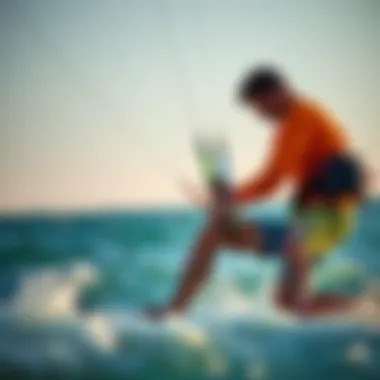
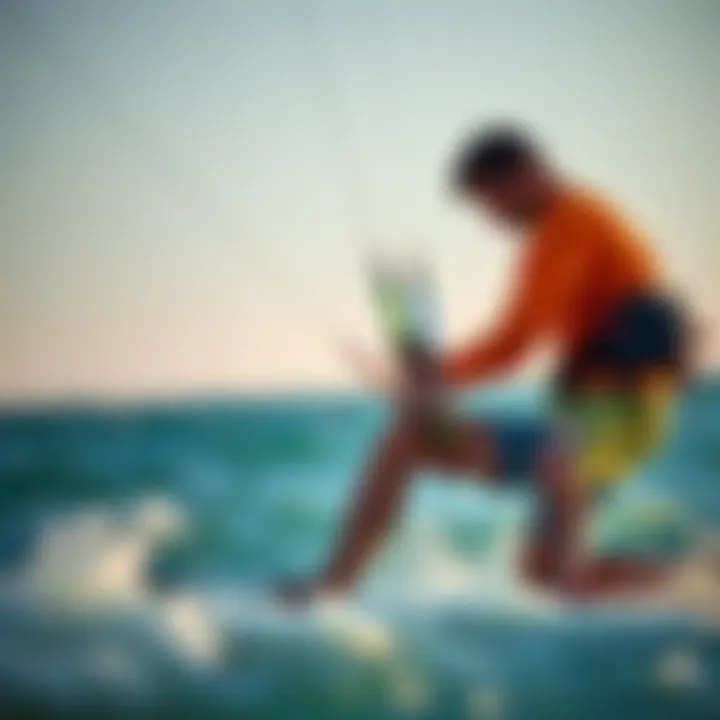
When it comes to buying gear, diving into the history of the equipment can be eye-opening. Don't be shy—ask the seller where the gear has been and how it’s been treated. You want to know about its life before it hits your hands. Has it bounced around in a trunk for years, or has it been cherished and taken care of? This info will shape your perspective on value.
If a kite’s previous owner is honest and forthcoming, it builds trust. Ask about repairs and adjustments made; even minor fixes can indicate heavy use. A clear history can save you from unexpected headaches down the line. Plus, when you get the scoop on the gear’s journey, it adds a bit of character to your eventual purchase.
Warranty and Return Policies
When diving into the world of kitesurfing gear sales, understanding the warranties and return policies can save your bacon. High-quality gear is often backed by a manufacturer's warranty, which can give you peace of mind. It shows accountability from the brand if something goes south. If you're shelling out serious cash, you want the assurance that they stand behind their product.
Conversely, not all sellers provide transparent return policies. A generous return window can be a game changer. If, by any chance, the gear doesn’t fit or works as intended, you should have options. It’s crucial to read the fine print.
"Buying the right kitesurfing setup is like gearing up for battle; the right tools make all the difference."
Maximizing Performance with Your Setup
Getting the most out of your kitesurfing gear can make or break your experience on the water. Maximizing performance means understanding both the setup of your kite and board, as well as establishing a routine for care and maintenance. A well-tuned kite allows you to harness the wind efficiently while a correctly adjusted board ensures stability and control over the waves. These elements are intertwined; neglecting one can diminish the potential of the other. Here, we explore the ins and outs of setting up your kite and board properly and maintaining your gear so that every session is as good as it gets.
Proper Setup Techniques
Adjusting Kite Settings
When it comes to adjusting kite settings, a few key variables come into play. These include the direction of the kite, the line tension, and the trim. Each of these settings can significantly affect how your kite performs in different wind conditions. For instance, if the kite is set too low, you may struggle with lift. Conversely, setting it too high can make drifting a challenge.
One crucial characteristic of adjusting kite settings is the ability to modify the trim line. This allows you to change the angle at which the kite flies. By finely tuning your kite’s settings, you can respond to shifting weather patterns, ensuring that you maintain control. The simplicity and significance of this adjustment make it a favored choice among enthusiast surfers.
- Unique feature: Adjusting kite settings on the fly means you don’t have to head back to shore when conditions change.
- Advantages: Immediate adaptability leads to a safer and more enjoyable experience.
- Disadvantages: Overthinking adjustments can lead to confusion and mistakes. Stick with what feels right for your level of experience.
Tuning Board for Conditions
Your board selection is not a one-size-fits-all scenario. Tuning your board for specific conditions—whether you’re facing flat waters or choppy waves—enhances how you ride. The adjustments can be as simple as altering foot strap positions or changing the fins’ configuration.
A significant aspect of tuning a board lies in selecting the right fin size. Larger fins offer better grip, while smaller ones promote speed and sliding. A well-tuned board allows for effortless transitions, making it easier to ride swells or catch rogue waves. This flexibility makes it a common consideration for advanced kiteboarders.
- Unique feature: Customizable configurations mean your board can evolve with your skill level and preferences.
- Advantages: Enhanced versatility gives you more freedom to experiment with style.
- Disadvantages: Too much adjustment can lead to instability if not executed carefully.
Regular Maintenance Practices
Cleaning Techniques
Keeping your kitesurfing gear clean is not just about aesthetics; it plays a vital role in performance longevity. Saltwater and sand can be corrosive, wearing down materials over time. A regular cleaning regimen helps prevent this deterioration.
One of the hallmark practices is rinsing with fresh water post-session. It’s a simple step that can save you a lot of trouble down the line. Consider using a soft cloth for the delicate surfaces of kites, as rough materials can cause unwanted scratches and scuffs. Cleaning your gear can become a ritual, a way to connect with your equipment while ensuring everything stays in tip-top shape.
- Unique feature: This practice enhances the lifespan of your gear, leading to lower replacement costs.
- Advantages: Regular maintenance can help you avoid emergency repairs and mishaps.
- Disadvantages: It might feel like a hassle after a long day on the water, there should always be a balance.
Storage Tips
Properly storing your gear is equally critical, especially in the off-season. A myriad of factors can affect your equipment—UV damage, moisture, and temperature fluctuations. Stashing your gear in a cool, dry place, ideally out of direct sunlight, preserves its quality.
Using gear bags specifically designed for kitesurfing will keep everything organized and protected from dings and scratches. Some kiteboarders advocate rolling their kites rather than folding them to prevent creasing that can weaken the structure.
- Unique feature: Organized storage ensures that your gear remains in ready-to-use condition.
- Advantages: Preventing damage from environmental factors can prolong the lifespan of your setup.
- Disadvantages: Maintaining an organized storage space can take effort and thought.
"A stitch in time saves nine—a well-maintained setup can mean the difference between trouble and tranquility on the water."
Insights on Popular Kitesurfing Models
When it comes to kitesurfing, the options for gear can feel as vast as an ocean. Each model has its own personality, designed to suit different styles and preferences of kiteboarders. Selecting the right equipment is paramount, as it not only influences performance but also contributes to safety and enjoyment on the water. Knowing which models are popular can steer first-time buyers towards making informed decisions while offering seasoned riders insight into upgrades that could improve their game.
Overview of Well-Regarded Brands
The reputation of kitesurfing brands often reflects years of innovation and commitment to quality. Below are some standout names that have carved their niche in kitesurfing gear, making them noteworthy for any kitesurfing setup.
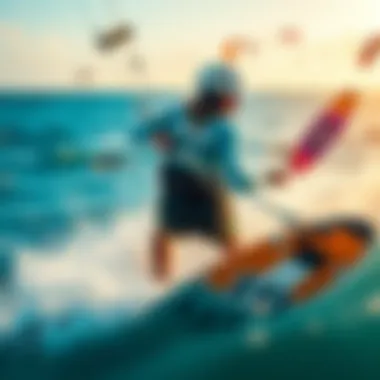
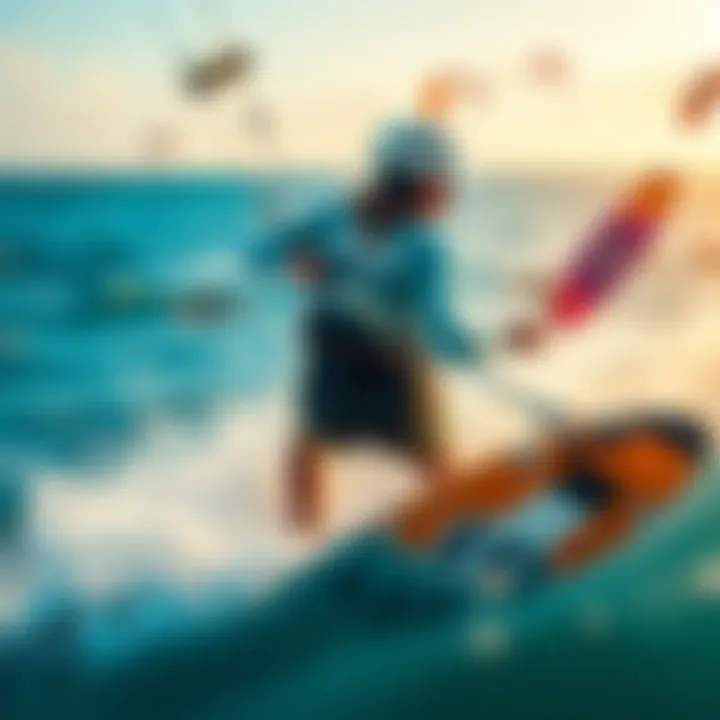
Naish Kites
Naish Kites has been a staple in the kitesurfing industry for decades. Known for their durability and versatility, these kites are designed with a range of riders in mind—from beginners buzzing with courage to experienced pros chasing the perfect wave. Their key characteristic is the balance they offer between power and control, giving riders confidence to take on varied conditions.
"Naish kites reflect a deep understanding of the sport’s needs and riders’ ambitions."
One unique feature of Naish Kites is their focus on advanced design technologies, like the Compression Control Valve that enhances airflow, maximizing performance. This aspect allows for an improved flying experience, although it might require a learning curve for novice users who are still figuring out the intricacies of kite handling.
Slingshot Boards
Slingshot Boards are renowned for their innovative designs that uphold responsiveness and stability. They often cater to freestyle riders who need boards that can handle tricks well. The key characteristic of Slingshot Boards is their durability; they are built tough to withstand the rigors of high-impact landings and rough waters.
A distinctive feature that sets Slingshot apart is their Hammerhead Technology incorporated in certain models. This unique tail shape allows for greater control and maneuverability, aiding riders in achieving those elusive spins and jumps. However, some users might find that the boards are on the heavier side, which can make them less ideal for quick tricks on lighter winds.
Duotone Innovations
Duotone is celebrated for pushing boundaries with their cutting-edge kites and boards. Their commitment to performance and quality shines through in their various models that cater to wave riding, freestyle, and everything in between. One of their notable key characteristics is the use of customizable components, enabling riders to tailor their setup for specific needs.
A highlight of Duotone is the incorporation of fin-less technology in some models, offering a unique riding experience that disrupts traditional design thinking. This provides a smoother ride and is notably advantageous in smaller waves. However, this innovation can also come with its challenges as it requires more skill to navigate effectively, particularly for newcomers learning the ropes.
Comparison of Checklist for Best Deals
When venturing into the realm of kitesurfing gear, a reliable comparison can help in making efficient decisions. To find the very best deals, it’s essential to evaluate price ranges and performance ratings.
Price Ranges
Understanding the price ranges of kitesurfing setups is crucial for budgeting purposes. The market has options catering to every wallet, from entry-level gear priced on the lower end to high-performance setups that demand a premium. This characteristic makes kitesurfing accessible, but it also necessitates careful consideration of what fits your level and aspirations.
A distinct feature to note is that often, investing in mid-range prices can yield better durability and performance than the lowest priced options, which might not last long under rigorous use. With seasonal discounts and second-hand marketplaces, buyers can snag solid gear without breaking the bank.
Performance Ratings
Having a grasp of performance ratings can guide kitesurfers on which models excel in specific conditions. Performance doesn't just reflect speed or ease of use; it encompasses how well the gear performs under different environmental factors.
For example, boards rated for better performance in choppy waters usually feature a different design and construction than those made for smoother conditions. Understanding these ratings helps kiteboarders choose setups tailored to their usual kiteboarding venues, thus avoiding unnecessary poor purchases. Similarly, high-performance gear tends to come at a higher cost, which is worth weighing against actual engagement in various riding styles.
The Future of Kitesurfing Gear
The evolution of kitesurfing gear is more than just a trend; it reflects a commitment to enhancing the rider's experience while also being mindful of environmental impact. As more and more kiteboarders look for sustainable and cutting-edge options, the future of kitesurfing gear presents itself as a thrilling blend of innovation and ecological consciousness. This section explores emerging technologies like eco-friendly materials and smart kites, as well as shifts towards new riding styles such as foil kitesurfing and hydrofoil innovations. Understanding these developments not only helps in selecting the right gear but also contributes to a more enjoyable and responsible kitesurfing experience.
Emerging Technologies in Kitesurfing
Eco-Friendly Materials
In recent years, there's been a noticeable trend towards using eco-friendly materials in kite manufacturing. These materials often include organic fibers and recyclable components. Their key characteristic is sustainability; they aim to reduce the carbon footprint of the production process. For example, many brands now focus on sourcing materials that are less harmful to the environment. This contributes significantly to the overall goal of making kitesurfing more responsible.
One unique feature of eco-friendly materials is their durability without sacrificing performance. However, some riders have noted that these materials can sometimes be pricier than conventional ones. Despite this, the long-term benefits for the environment and consumer health tend to outweigh initial costs. In addition, choosing gear made from eco-friendly materials promotes a wave of conscious consumerism in the kitesurfing community.
Smart Kites: Trends in Innovation
On a different front, smart kites are capturing attention as pioneers of technology in kitesurfing. These kites often come equipped with sensors and integrated technology that allows for extensive data collection, ranging from wind speed to rider performance metrics. The main draw here is customization; they adjust automatically to changing conditions, thereby enhancing the rider's performance.
The unique advantage of using smart kites is that they can significantly reduce the learning curve for beginners. However, they also come with a higher price tag and require a bit of tech-savviness. Riders should weigh the pros and cons of diving into technological features against their own kitesurfing experience. These innovations may pave the way for a more intuitive approach to the sport, making it accessible to a broader audience.
Adapting to New Riding Styles
Foil Kitesurfing
Foil kitesurfing has made quite a splash lately, capturing the imagination of both seasoned and novice kiteboarders alike. The key upside of foil kiting is its ability to glide smoothly over water, even in lighter wind conditions. The essential characteristic of foil kites lies in their design; they incorporate hydrofoil technology that elevates the board off the surface, creating a unique sensation akin to flying. This aspect opens up new riding possibilities, allowing for greater versatility in various water conditions.
However, this style does demand a different skill set and a deeper understanding of how the board interacts with the water. Riders may find initial attempts challenging, but many agree that the learning process can lead to a much more rewarding experience. Whether or not foil kitesurfing fits into a rider's repertoire is a matter of personal preference, but its popularity suggests it’s here to stay.
Hydrofoil Innovations
Hydrofoil innovations complement the growing interest in foil kitesurfing. Manufacturers are producing boards and hydrofoils that provide better lift and stability. These innovations not only enhance performance but also contribute to a more exhilarating ride. The key feature of hydrofoils is their underwater wing design, which generates lift as speed increases. Riders can enjoy quicker takeoffs and smoother rides, even on choppy waters.
Yet, as with any new technology, there are both benefits and drawbacks. Hydrofoils can be pricier and may require specific gear for compatibility. However, many kitesurfers feel that the investment is justified by the thrill of soaring over the waves.
Ultimately, as embracing new technologies becomes commonplace, understanding the potential of modern kitesurfing gear ensures that enthusiasts can stay ahead of the curve while enjoying a sustainable and exhilarating sport. This future is not just about the evolution of equipment; it also reflects a community eager to adapt and innovate.



